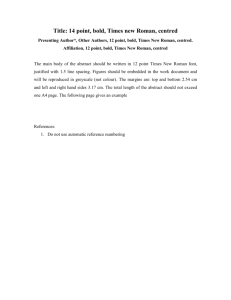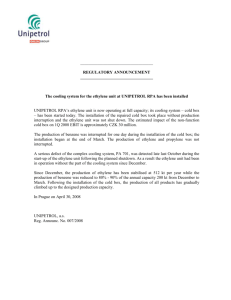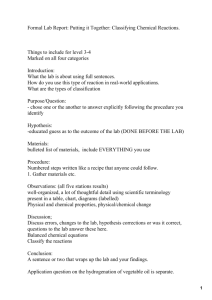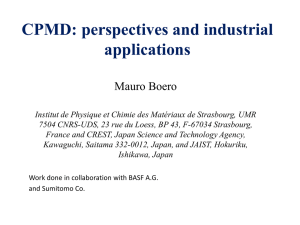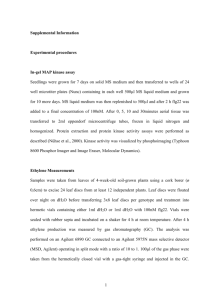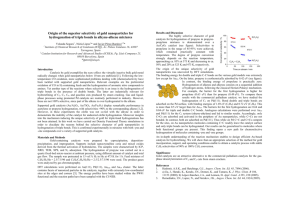Nanostructured Catalysts Abhaya K. Datye University of New Mexico
advertisement
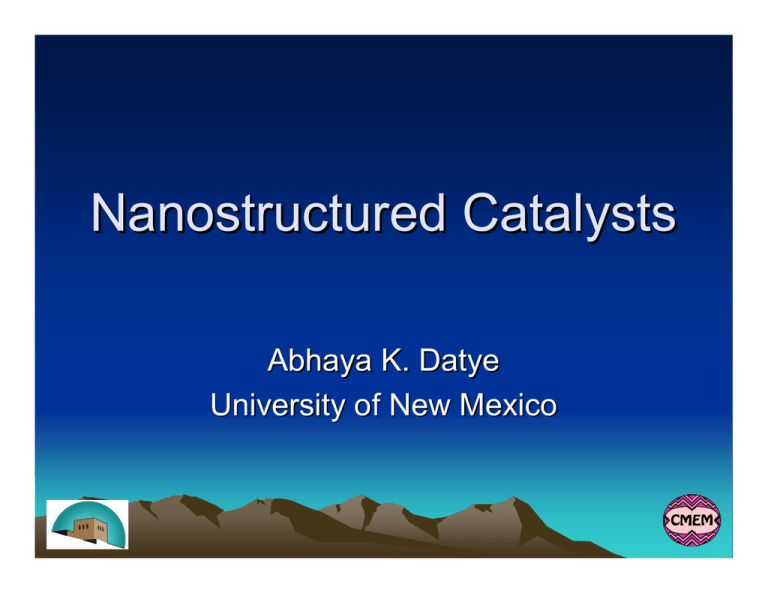
Nanostructured Catalysts Abhaya K. Datye University of New Mexico Issues • Control of surface composition • Facile synthesis via self assembly • Aggregation of nanoparticles Control of Surface Composition and Structure in Nanoparticles • Selective catalysts often involve more than one element • Thermodynamics, preparation variables, often dictate the surface composition and structure • How do we generate tailored surface structures Restructuring of Pd-Ag Catalysts During Selective Hydrogenation of Trace Acetylene in Ethylene K. Lester, Y. Jin, H. Zea and A. K. Datye University of New Mexico, Center for Microengineered Materials and Department of Chemical & Nuclear Engineering, Albuquerque, NM 87131, USA E. G. Rightor1, R. J. Gulotty1, J. J. Maj1, J. Blackson1, M. Holbrook2 and C. Michael Smith3 The Dow Chemical Company, 1Midland, MI, 48674, 2Plaquemine, LA 77565, 3Freeport, TX 77541, USA. Financial support provided by the U. S. DOE, Office of Basic Energy Sciences, grant DE-FG0398ER14917 and by the Dow Chemical Company Restructuring of Pd-Ag Catalysts During Selective Hydrogenation of Trace Acetylene in Ethylene • • • • Industrial feedstock for the production of ethylene polymers must contain no more than 5-10 ppm of acetylene. Selective Hydrogenation of acetylene is used to remove trace acetylene C2H2 + H2 Æ C2H4 + H2Æ C2H6 Ethylene selectivity is a key objective in this process. Catalysts are subject to thermal runaway due to the exothermic reaction Operating Conditions • Our reaction conditions correspond to the ‘front end’ hydrogenation, where acetylene is present with a large excess of ethylene and also an excess of hydrogen and some CO. • Feed:30% C2H4, 0.4% C2H2, 0.1% CO, 16% H2 and balance N2. Hydrocarbon byproduct formation is suppressed on Pd-Ag after HTR Selectivity to Oligomers vs Delta Temperature 0.35 Pd/Al2O3 No pretreatment Selectivity to Oligomers 0.3 0.25 0.2 Pd+Ag/Al2O3 0.15 500 C Pretreatment 0.1 0.05 0 -25 -20 -15 -10 -5 0 5 10 Delta Temperature 15 20 25 High Temperature Reduction Causes a Drop in Activation Energy for Ethylene Hydrogenation on Bimetallic Pd-Ag catalysts Selectivity = moles ethylene produced moles acetylene reacted C2H2 Æ C2H4 Æ C2H6 Arrhenius plot for 0.5 Pd - 0.5 Ag/SiO2 catalysts 0.5Pd-0.5Ag / SiO2 Catalysts - Selectivity Vs Delta Temperature. -13 Eactivation (kcal/mol) = 20.5 + 0.4 0.5 0 ln(Ethene formed) Ethylene Selectivity 1 -0.5 -1 -1.5 -2 -15 -17 Eactivation (kcal/mol) = 13.5 + 0.3 -2.5 0 10 20 Delta Temperature (oC) Reduced at 500 C Reduced at 100 C 30 40 -19 0.0024 0.0026 0.0028 1/T (1/K) Reduced at 500 C Reduced at 100 C ∆T = reaction temperature – clean up temperature Clean up temperature is the temperature at which 99% of acetylene conversion is obtained Ethylene Hydrogenation Is A Structure-Insensitive Reaction Why should the activation energy for ethylene hydrogenation be affected by pretreatment? Effect of CO adsorption on Activation Energy for Ethylene Hydrogenation If the surface is covered by CO, the activation energy for ethylene reaction is simply the heat of desorption of CO Therefore, changes in the heat of desorption of CO can change the activation energy for ethylene hydrogenation On Pd/SiO2, CO is adsorbed mainly in a bridged mode There is no effect of pretreatment Bridge Bridge Linear Reduced at 70 C Linear Reduced at 400 C On Pd-Ag/SiO2, we see more linearly bound CO than bridged. High temperature reduction further affects the relative concentrations of linear vs bridged CO Bridge Linear Bridge Linear Reduced at 70 C Reduced at 400 C Effect of Reduction Temperature Pd-Ag alloy, with some phase segregation Ag redistributes causing a breakup of the Pd ensembles Low temperature reduction High Temperature reduction Pd/ SiO2 We see no effect of pretreatment on ethylene hydrogenation activation energy Activation Energy as Activation Energy (Apparent) kcal/mol Pretreatment a function 100 C of Pretreatment 500 C 28 27 The apparent activation energy for ethylene hydrogenation on Pd is consistent with the heat of adsorption of CO. From the literature, the heat of adsorption for bridged CO ranges from 22-40 kcal/mol depending on coverage. Bridged CO is more strongly bound than linearly bonded CO Heats of Adsortion of the Adsorbed CO Species on the Various Pd-Cointaining Solids at Low (E0) and High (E1) Coverage [1] Linear CO species Bridged CO Species Sample E0 (kcal/mol) E1(kcal/mol) E0 (kcal/mol) E1(kcal/mol) Pd (Cl-free)/Al2O3 22 13 40 22 Pd (Cl)/Al2O3 22 13 40 18 Pd (Cl-f)/CeO2/Al2O3 22 13 40 22 Pd (Cl)/CeO2/Al2O3 22 13 40 16 Pd (Cl)/La2O3/CeO2/Al2O3 22 13 40 25 (Cl-f): Chlorine free solid (Cl): Chlorine containing solid [1] Dulaurent O, Chandes K, Bouly C and Bianchi D, Journal of Catalysis, v 192(#2), 2000 Arrhenius plot for Ethylene Hydrogenation on 0.5 Pd - 0.5 Ag/SiO2 catalysts -13 ln(Ethane formed) Eactivation (kcal/mol) = 20.5 + 0.4 -15 -17 Eactivation (kcal/mol) = 13.5 + 0.3 -19 0.0024 0.0026 1/T (1/K) Reduced at 500 C Reduced at 100 C 0.0028 Schematic of Restructuring Phenomena in Pd-Ag High Temperature Reduction High Temp Oxidation PdO Ag Pd-Ag alloy Enrichment of Ag on Pd surface Pd Low Temp Oxidation Ag2O Summary • High temperature pretreatments cause restructuring of Pd and Ag • Reducing the number of Pd nearest neighbors affects selectivity to oligomer formation • By modifying the adsorption of coadsorbed CO, we can control the activation energy for ethylene hydrogenation and modify the selectivity for the reaction Aerosol Synthesis of Nanostructured Catalysts Mangesh Bore, Hien Pham, Timothy Ward, C. J. Brinker, Abhaya Datye Financial Support provided by NSF – NIRT, Center for Ceramic and Composite Materials and by the Materials Corridor Council Autoclave Route Reaction Mixture Autoclave 150 oC 48 hours Filtration Calcination • Liquid-Crystal Template Mechanism – Proposed by C. T. Kresge et al., Nature (1992) J. S. Beck et al., J. A. C. S. (1992) MCM-41 Irregular shapes Aerosol Route Calcination • Evaporation Induced Self Assembly (EISA) – Proposed by Jeffrey Brinker et. al., Nature (1999) – Evaporation of solvent leads to ordering of surfactant structures – Condensation of silica follows the formation of templated structures to lock in the structure Control of Particle Structure Y. Lu, H. Fan, A. Stump, T.L. Ward, T. Rieker, C.J. Brinker, Nature 398 (1999) 223 Hexagonal nanostructure: interconnected hexagonally packed spherical pores, 1200 m2/g, d=3.2 nm (5 wt% CTAB) cubic nanostructure: interconnected pores arranged in simple cubic lattice (4.2 wt% B56) lamellar “onion-skin” structure: concentric shells of silica separated by pore volume, 478 m2/g, d=9.2 nm (5wt% P123) Comparison Aerosol Synthesis Autoclave Synthesis • Continuous process • Batch process • Reaction time seconds • Reaction time hours • Spherical particles • Irregular shapes • 3-D interconnected pore structure (local order is hexagonal) • Most common is the 2-D structure TEM Regular shapes Particle consists of small ordered domains of pores After Hydrothermal Stability Test at 750°C SiO2 10% water vapor, 2 hours Si/Al 20 Aluminum incorporation improves the hydrothermal stability of mesoporous silica particles. Hydrothermal Stability Test (batch vs. aerosol route) 10% water vapor, 2 hours 1600 Si/Al molar ratio 20 1400 Surface Area (sq m/gm) 1200 Batch Si-Al Aerosol Si-Al 1000 800 600 Aerosol Silica 400 Davisil silica gel 200 Batch Silica 0 Initial 500 550 600 Temperature (C) 650 700 750 TEM/STEM images of Au/NH2-MCM-41 The average Au nanoparticle diameter is small (~1 nm), and the nanoparticles are dispersed inside the pores. 3-aminopropyltrimethoxysilane is used as the amine source TEM Images of Ordered Nanocrystal/Silica Nanostructures Before calcination [100] A 20 nm B C Courtesy of Hongyou Fan, Jeff Brinker Sandia National Laboratories Diffusion of Three-Dimensional Metal Particles on an Oxide Substrate: Implications for the Sintering of Heterogeneous Catalysts Lani Miyoshi Sanders Abhaya K. Datye Univ. of New Mexico, Albuquerque, NM Brian Swartzentruber Sandia National Labs, Albuquerque, NM Experimental Approach: Atom-Tracking Scanning Tunneling Microscopy of Pd/TiO2(110) Conventional STM Si-Ge AdDimer on Si(001) Each image takes several seconds, missing many rotation events… Atom Tracking g TipSTM y time resolution 1000x t1 t2 x Developed by Brian Swartzentruber, Sandia Labs TiO2(110) Surface 3Åx6.5Å Unit cell 100x100Å2 From: M.J.J.Jak, Ph.D. Dissertation, Nov. 2000. Depositing Pd 300x300Å2 Fast deposit @ 4 W, 2 s 300x300Å2 Slow deposit @ 3 W, 4 min Diffusion Characteristics Presence of small, mobile particles rapidly decays due to pinning and growth Diffusion is essentially confined to the [001] direction Step decoration is prevalent only on steps perpendicular to [001] 400x600Å2 Diffusing particles hop discretely with length of underlying unit cell of substrate Y (Angstrom) Atom-Tracking of Pd Particle Diffusion [001] 165 165 160 160 155 155 150 150 145 145 140 140 135 135 130 145 155 X (Angstrom) 130 100x100Å2 0 10 20 30 Time (s) 40 50 Diffusion Coefficient (cm^2/s) Scaling Analysis for Pd Particle Diffusion 1E-14 n=0.86±0.09 1E-15 1E-16 n=1.07±0.10 n=1.06±0.10 1E-17 1 10 Particle Size (# of Atoms) 100 42°C 36°C 25°C 3-D Monte Carlo model gives insights into decreased motion of larger particles disordered surfaces hopping d-1 high surface free energy very small particles shift in diffusion mechanism grow shift in scaling law larger particles periphery diffusion d-7 faceting 300x300Å2


